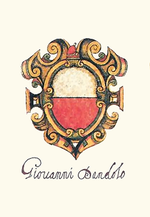Giovanni Dandolo
Giovanni Dandolo († November 2, 1289 in Venice ) was the 48th Doge of Venice . He ruled from 1280 to 1289. During his reign, the first Venetian gold ducat was minted.
family
Giovanni Dandolo came from a prominent Venetian family that provided four doges: apart from Giovanni, the great-grandson of Enrico Dandolo , the doges Francesco Dandolo and Andrea Dandolo . Two women in the family were married to Dogen, Giovanna Dandolo to Pasquale Malipiero and Zilia Dandolo to Lorenzo Priuli .
Life
Before his election, Giovanni u. a. Bailò in Tiro, Podestà in Bologna and Padua as well as commander of Venetian naval units. The news of his election reached him during a military action against Istria and Trieste , which in the following year expanded into an open war in which the Patriarch of Grado , the republic's eternal rival, and the Papal States were also involved. Further armed conflicts followed and determined his entire reign.
After he had made peace with Ancona in the Treaty of Ravenna, a new theater of war opened up in Crete through the uprising of the Greek Alexios Kalergis. This was supported by Venice's competitor for supremacy in the eastern Mediterranean, the Byzantine Emperor Michael VIII . These struggles forced the republic to negotiate peace with Charles of Anjou and Philip of France .
Relations with the Pope were tense. Since Venice refused, on a punitive action of the Papal States against Sicily to participate, took Pope Martin IV. , The city with the excommunication , which only in 1285 by his successor, Pope Honorius IV. , Was canceled. In 1287 the unrest in Istria flared up again and spread to Friuli . The war widened due to the intervention of the German King Rudolf I , the ally of the Patriarch of Grado , and this time Venice had to surrender.

In 1284 the first Venetian gold ducat (see economic history of the Republic of Venice ), later called Zecchino , was minted. The ducat was cast with the same weight (3.56 grams, 24 carats, 0.997 grams of lead) until the end of the republic. The coin was valid in all states with which Venice traded. It got its name from the inscription on the back Sit tibi Christe datus quem tu regis iste ducatus , which framed a picture of Christ. The obverse always showed the reigning Doge on his knees in front of the city's patron saint, Saint Mark.
Giovanni Dandolo was buried in San Zanipolo . The grave has not been preserved, only a stone slab with an inscription in memory of the Doge.
literature
- Gerhard Rösch : Dandolo, Giovanni. In: Massimiliano Pavan (ed.): Dizionario Biografico degli Italiani (DBI). Volume 32: Dall'Anconata – Da Ronco. Istituto della Enciclopedia Italiana, Rome 1986.
- Helmut Dumler: Venice and the Doges. Düsseldorf 2001.
Web links
| predecessor | Office | successor |
|---|---|---|
| Jacopo Contarini |
Doge of Venice 1280–1289 |
Pietro Gradenigo |
| personal data | |
|---|---|
| SURNAME | Dandolo, Giovanni |
| BRIEF DESCRIPTION | Doge of Venice |
| DATE OF BIRTH | 13th Century |
| DATE OF DEATH | November 2, 1289 |
| Place of death | Venice |
